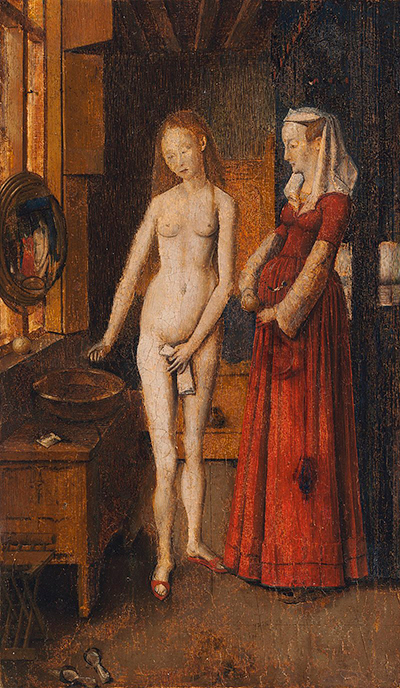Woman Bathing was a painting by Jan van Eyck produced somewhere between the 1420s to the early 1430s. It has unfortunately been lost in the years that have passed since but a number of copies made of it allow us to understand how the original might have looked.
Upon viewing the composition of the various copies made of his original artwork, one is immediately struck by the similarities that exist between them and one of Van Eyck's most famous paintings, namely Arnolfini Portrait. They are both indoor, settings with two figures stood close to each other and surrounded by the various inventory of the room. One can immediately accept from that that this may have been similar to another painting from his own hand. The areas around what we now know as the Netherlands and Belgium hosted a fine selection of artists and studios in and after the period in which Van Eyck was around, and so there was no shortage of people willing to mimic the old master as a means to show respect and also to develop their own technical expertise.
It is rare to think of nude artworks within this artist's career but actually there is evidence to suggest that he did the same elsewhere. Various documentation from the following centuries after his death have also mentioned this particular painting, or at least described something very similar, and so the rumours of its existence are most likely to be true. We are, unfortunately, left in the predicament of having to examine other artist's copies of it and then estimate how accurate they were to the original. This level of confusion is not rare within Van Eyck's career, with a number of his pieces being questioned as to their attribution and this case is not helped by the fact that we know he also worked in collaboration with others on a number of pieces. His assistants would be called in to work on less significant parts of each panel, under his guidance.
Based upon the copy in front of us, from an unknown Netherlandish artist from the following century, there would have been a female preparing to bathe, with a maid or friend stood alongside her helping out. There sits a bed to the side, and a small chest besides the wall, with a mirror which reflects their own appearance within it. She protects her modesty with a small towel to avoid upsetting conservative minds of that era, just as Michelangelo would have to do within his Sistine Chapel murals. A small amount of light is allowed in from the left hand side, though not enough to saturate the content too much.




